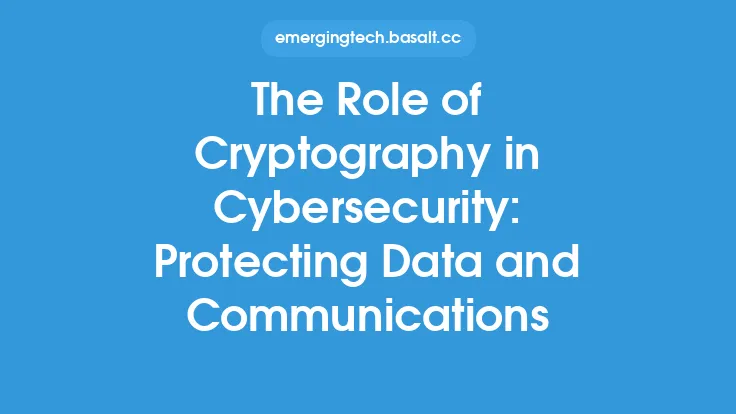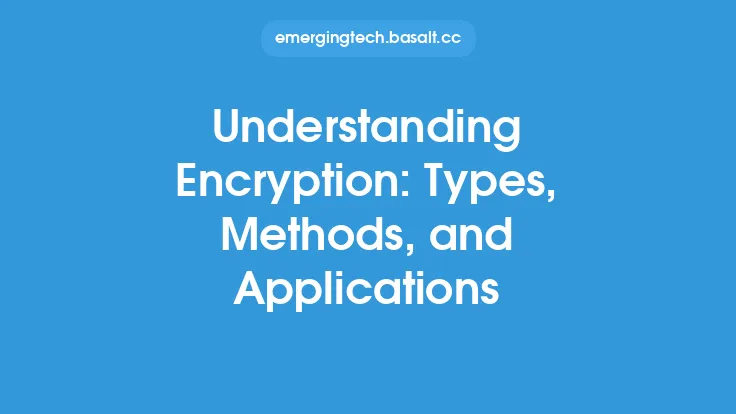Public-key cryptography, also known as asymmetric encryption, is a method of encrypting data using a pair of keys: a public key and a private key. This approach to cryptography is widely used in various applications, including secure web browsing, email, and virtual private networks (VPNs). In this article, we will delve into the details of how public-key cryptography works, its underlying principles, and its applications.
Introduction to Asymmetric Encryption
Asymmetric encryption is a type of encryption where the key used for encryption is different from the key used for decryption. This is in contrast to symmetric encryption, where the same key is used for both encryption and decryption. In asymmetric encryption, a pair of keys is generated: a public key and a private key. The public key is used for encryption, while the private key is used for decryption. This approach provides a secure way to exchange encrypted data between parties without having to share the same secret key.
Key Generation
The key generation process in public-key cryptography involves creating a pair of keys: a public key and a private key. This is typically done using a key generation algorithm, such as the RSA algorithm. The algorithm generates a pair of keys based on a set of parameters, including the key size and the public exponent. The public key is used to encrypt data, while the private key is used to decrypt the encrypted data. The private key is kept secret, while the public key is shared with others.
Encryption and Decryption
The encryption process in public-key cryptography involves using the public key to encrypt the data. The encrypted data is then sent to the recipient, who uses their private key to decrypt the data. The decryption process involves using the private key to reverse the encryption process, resulting in the original plaintext data. The encryption and decryption processes are based on mathematical algorithms, such as the RSA algorithm, which uses modular exponentiation to encrypt and decrypt data.
Mathematical Background
The mathematical background of public-key cryptography is based on number theory and algebra. The RSA algorithm, for example, is based on the difficulty of factoring large composite numbers into their prime factors. The algorithm uses modular exponentiation to encrypt and decrypt data, which is based on the properties of modular arithmetic. The security of public-key cryptography relies on the difficulty of certain mathematical problems, such as factoring large numbers and computing discrete logarithms.
Security Benefits
Public-key cryptography provides several security benefits, including confidentiality, integrity, and authenticity. Confidentiality is ensured by encrypting the data using the public key, which makes it difficult for unauthorized parties to access the data. Integrity is ensured by using digital signatures, which verify that the data has not been tampered with during transmission. Authenticity is ensured by using digital certificates, which verify the identity of the parties involved in the communication.
Applications
Public-key cryptography has several applications in various fields, including secure web browsing, email, and virtual private networks (VPNs). Secure web browsing uses public-key cryptography to establish a secure connection between the client and the server, ensuring that the data exchanged between them is encrypted and secure. Email uses public-key cryptography to encrypt and decrypt emails, ensuring that the contents of the email are confidential and authentic. VPNs use public-key cryptography to establish a secure connection between the client and the server, ensuring that the data exchanged between them is encrypted and secure.
Key Management
Key management is an essential aspect of public-key cryptography, as it involves managing the public and private keys used for encryption and decryption. Key management includes generating, distributing, and revoking keys, as well as ensuring that the private key is kept secret. Key management is critical to ensuring the security of public-key cryptography, as a compromised private key can compromise the security of the entire system.
Attacks and Vulnerabilities
Public-key cryptography is vulnerable to certain attacks and vulnerabilities, including brute-force attacks, side-channel attacks, and quantum computer attacks. Brute-force attacks involve trying all possible combinations of keys to decrypt the encrypted data. Side-channel attacks involve exploiting information about the implementation of the algorithm, such as timing and power consumption. Quantum computer attacks involve using quantum computers to factor large composite numbers, which can compromise the security of public-key cryptography.
Conclusion
Public-key cryptography is a widely used method of encrypting data using a pair of keys: a public key and a private key. The approach provides a secure way to exchange encrypted data between parties without having to share the same secret key. The security of public-key cryptography relies on the difficulty of certain mathematical problems, such as factoring large numbers and computing discrete logarithms. While public-key cryptography is vulnerable to certain attacks and vulnerabilities, it remains a widely used and effective method of securing data in various applications.





